Part 2. General Follow Up and Recent Developments
Inevitably with a publication of this kind, people come forward with more information or to tell that “that is not right”. The group producing this could however only go on the information available at the time. Pending more research and the production of a second edition, further information will be posted on this website from time to time.
Note: The first edition sold well, far exceeding the expectations of the group.
January 2010
AERIAL PHOTOGRAPH
On the very weekend that the printed copies were delivered, an aerial photograph of the village dated 1948 was discovered in the archives of the Cockermouth Museum Group.
[Note: the Kirkgate Museum Group changed its name in 2009 so that ‘Cockermouth’ appeared in its title.]
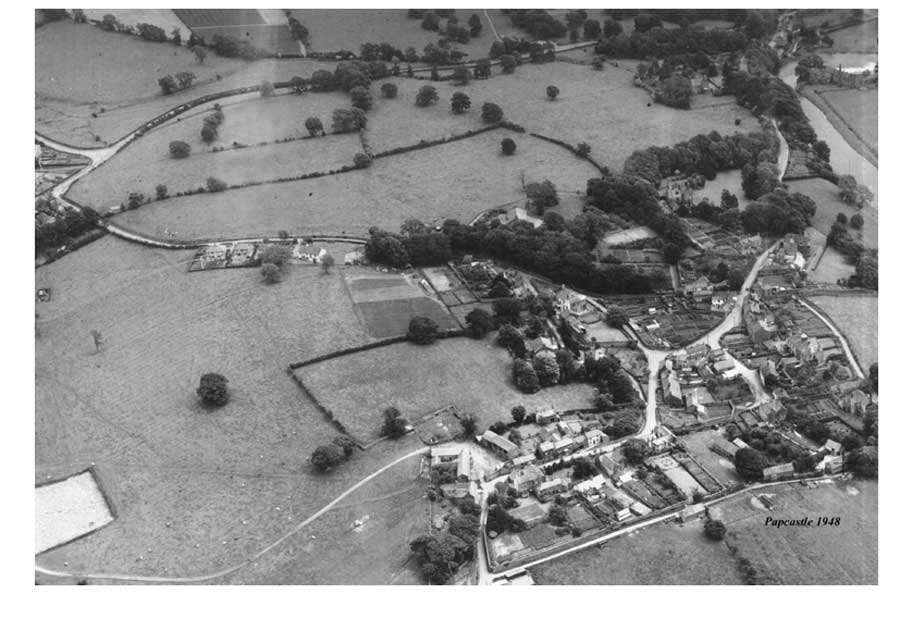
By permission of Cambridge University Collection of Air Photographs, Unit for Landscape Modelling.[ref: BC6, 7th June 1948] This might well be one of the earliest such photographs of the village.
Of note are:-
- The Mount – house and grounds
- The Moses Market Garden – now occupied by Fellbarrow, The Hawthorns, Grasmoor and Silverstones
- The existence of the back lane behind Oak Cottage, Nutwoods Cottage and 1 Oakleigh Terrace
EVACUEES
At the outbreak (and even before on 1st September 1939) major cities sent their children in significant numbers to country towns and villages for safety. The operation code named ‘Pied Piper’ lasted only a short time to start with so that by January 1940 some 60% had returned home. Further waves of evacuation followed however, in June 1940 (after Dunkirk), then September 1940 ( the Blitz) and again 1944 when V1 Flying Bombs and V2 rockets were used against Britain. In total some 3.5 million people were evacuated at some time.
In Papcastle there are some memories (information supplied by Basil Sedgwick)
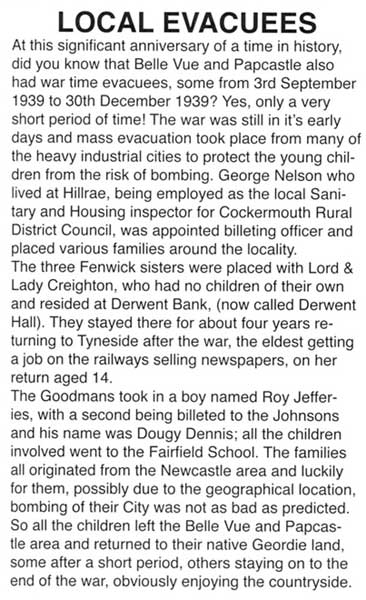
FLOODS
The village houses (today) nearly all stand high enough above the flood plain of the River Derwent. Cockermouth itself and the Gote area ( which was part of the village until 1935) have always been prone to flooding.
Dates which are memorable include 1761, 1771, 1852, 1874, 1918, 1931, 1936, 1966, 2005 (when Cumbria was inundated and Carlisle suffered particularly badly.)
Bradbury (in his “History of Cockermouth”), has recorded some of the details of events in many of the above.
So it could have been no surprise on 19th November 2009, when a ‘tidal wave’ swept down the Cocker, came down South St, Challoner Street and into Main Street in minutes between 2.00 and 3.00 pm that afternoon.
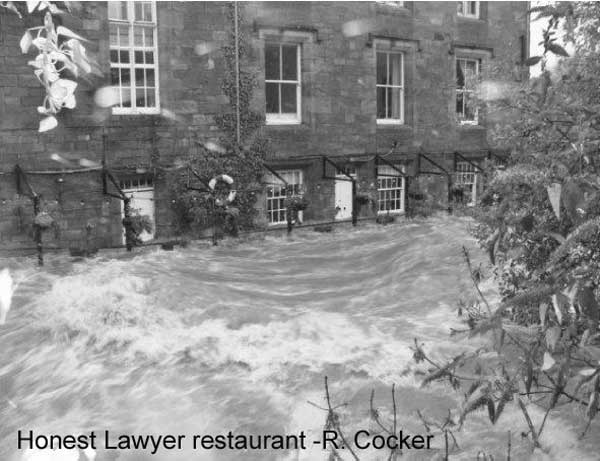
During the night water reached 2.5 m (8 feet) [as it did in one Market Street court in 1938.] Such as the New Bookshop had water to the top of its windows.
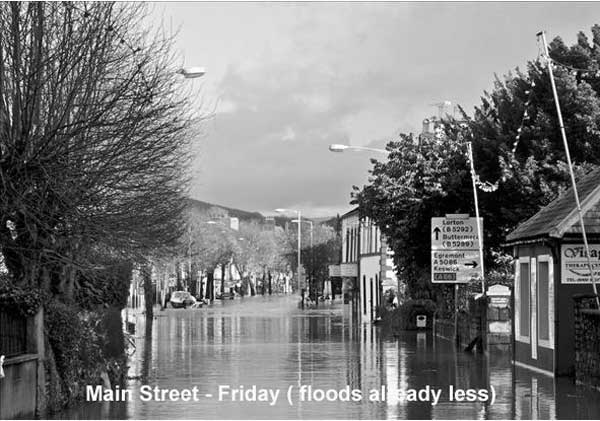
There were magnificent rescue operations performed all night and through the following day by the RAF Rescue helicopters, Mountain Rescue teams , Lifeboats and many others.
The primary cause of the river bursts was a long period of exceptional torrential rain over the fells on top of ground already saturated with much rain earlier in the month.- Seathwaite in Borrowdale, known as the wettest place in England, recorded 246.6 mm in 24 hours (and a British record of 377.8 mm in 34 hours), possibly 1000 mm in the month of November.
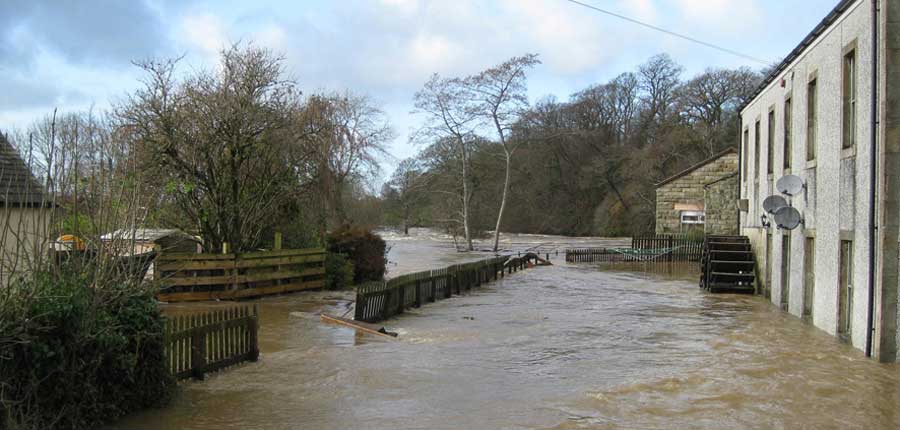
Apart from the groundfloor properties at the converted Old Pump House which were inundated, Papcastle itself saw only the tremendous overflow onto the flood plain fields, with the fields by Stoddart Hole being covered with a deep layer of gravel and boulders over a very wide area. The Old Corn Mill ground floor properties, also flooded, are in fact not in Papcastle – the parish boundary runs between the Old Pump House and the old Corn mill.
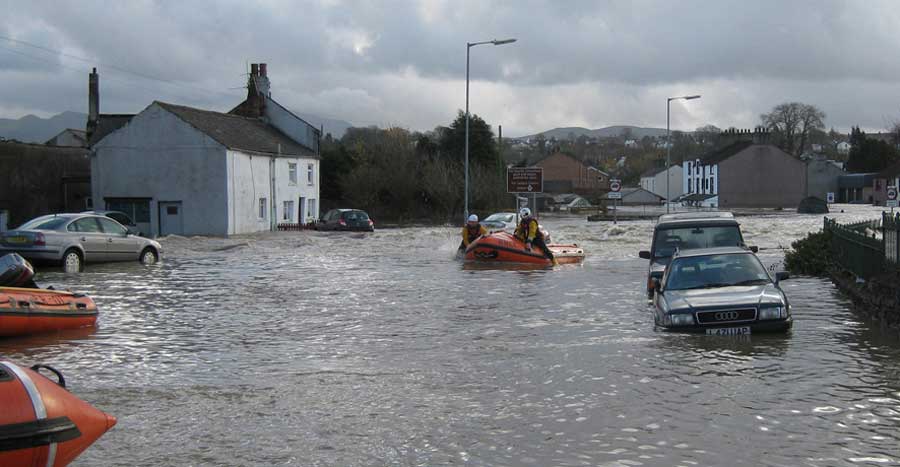
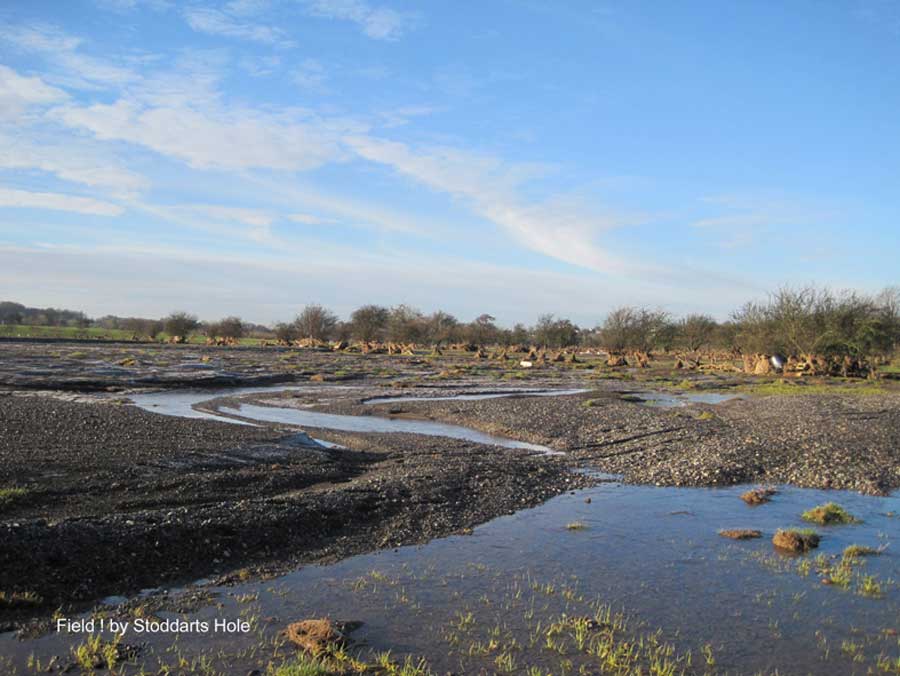
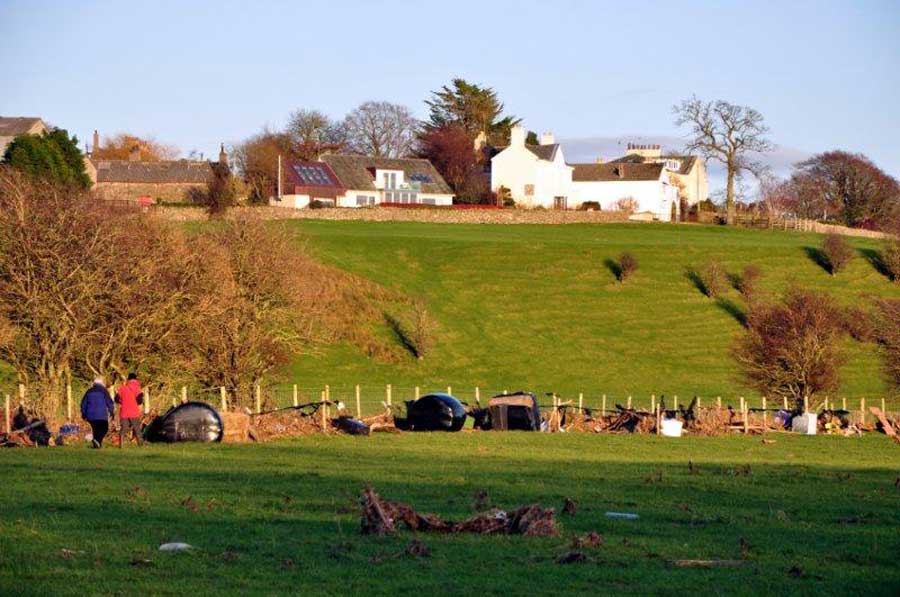
Tideline Below the Village
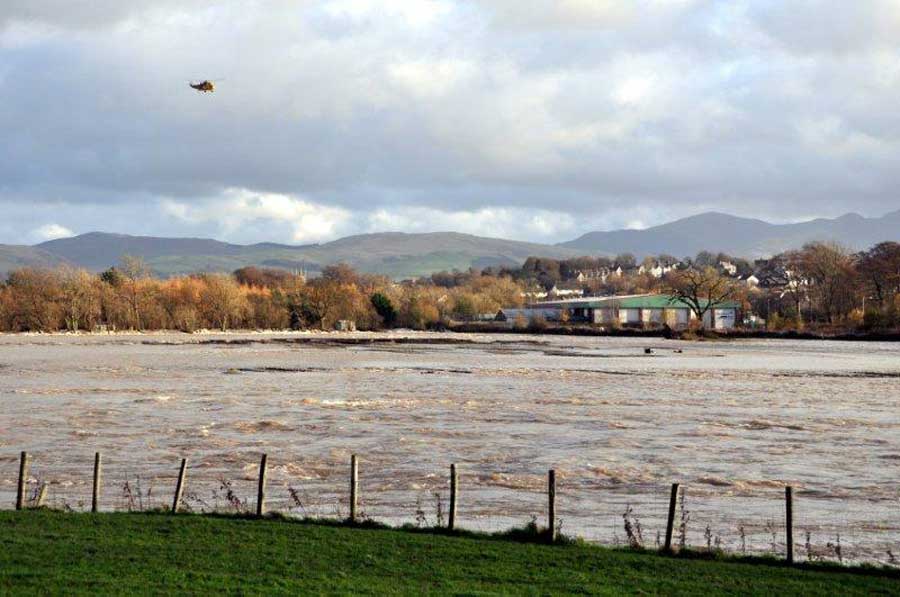
River Derwent across to Listers Lakes Centre
The piers of Papcastle Bridge have been heavily scoured, but after a bridge closure scare, the bridge itself was considered safe and was reopened as the only crossing of the River Derwent as far as Keswick.The banks of the river, mainly below Papcastle Bridge were also scoured and the river considerably widened.
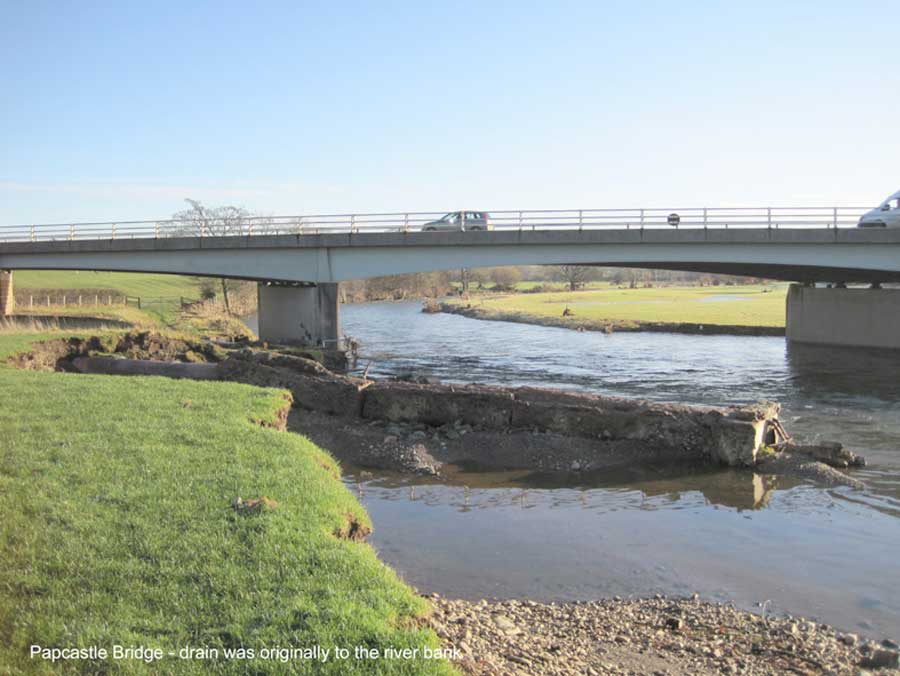
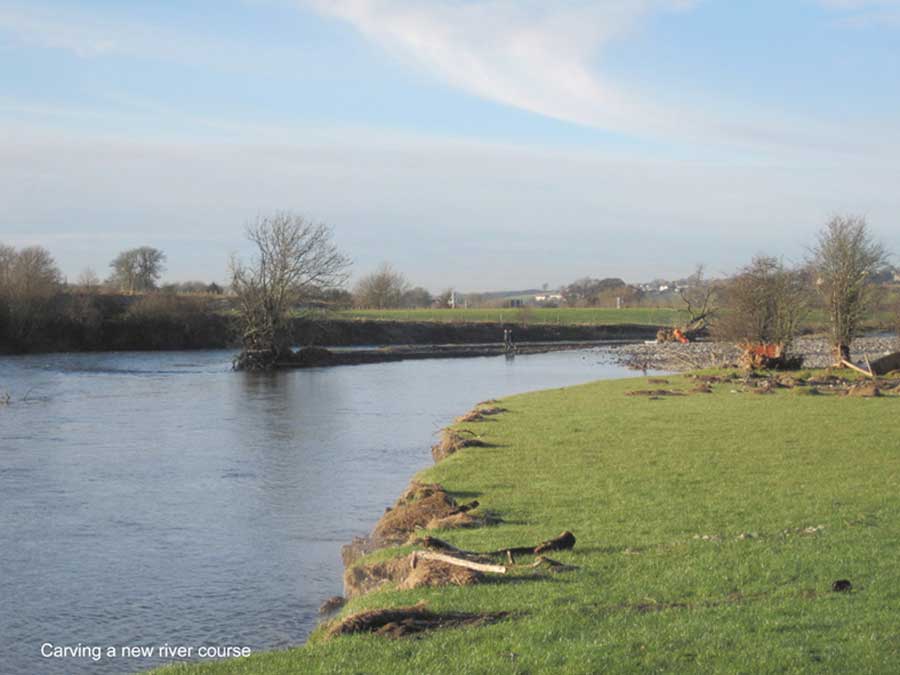
The indirect effects however came from the destruction and closure (pending safety clearance) of so many bridges over the Cocker and Derwent.
Road Bridges
In Workington,
Northside bridge collapsed
Calva Bridge became extremely unsafe.
Upstream, Broughton Bridge was damaged and closed,
Gote Bridge which had large sections of its parapet walls swept away closed;
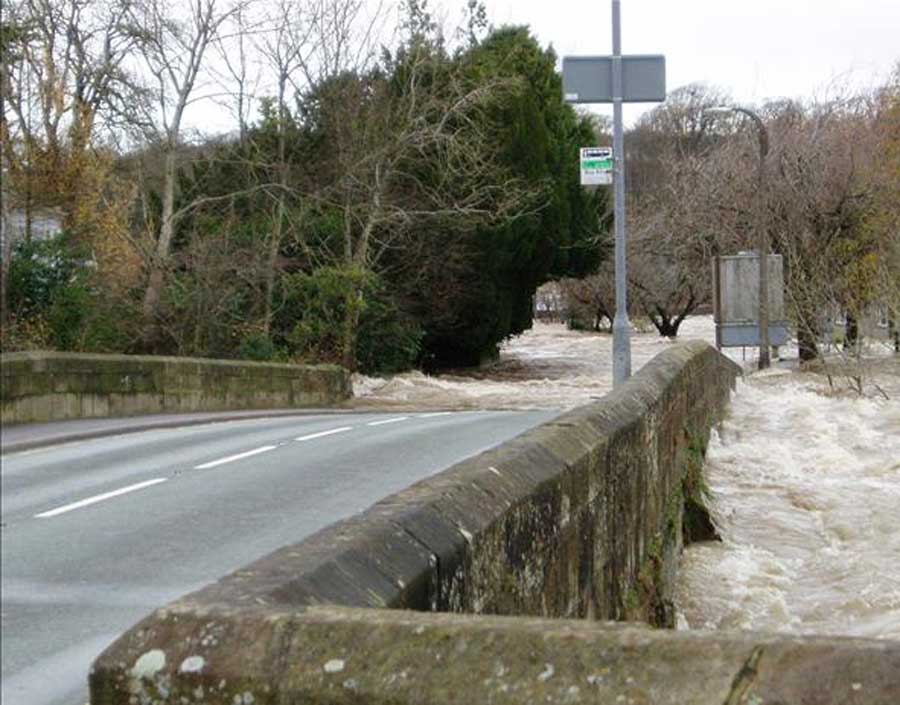
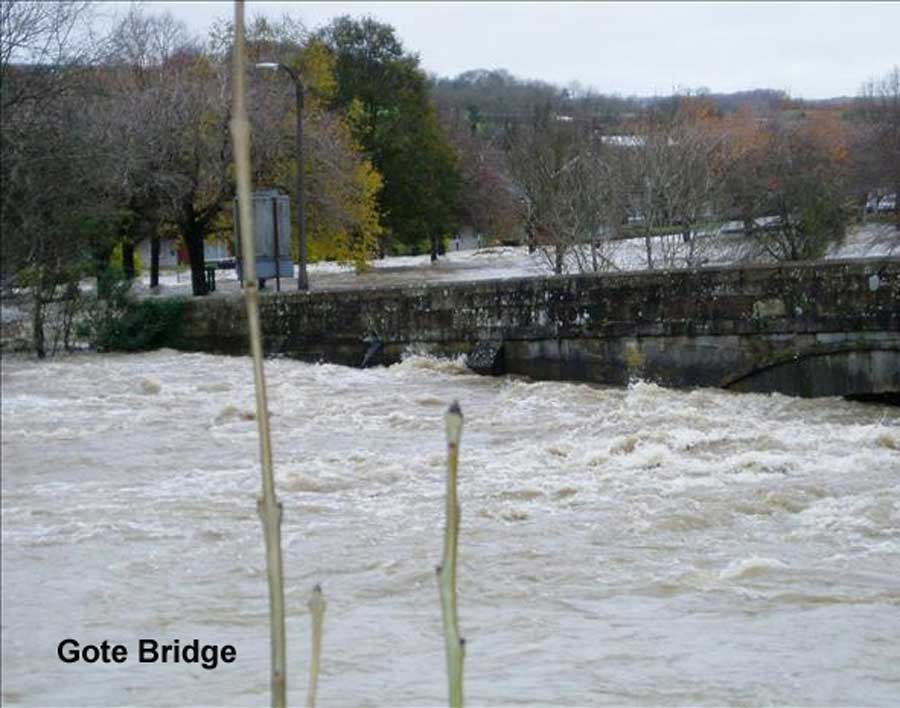
Cocker Bridge (Main Street to Market Place) was closed with a very large tree smashed into it.
Isel and Ouse Bridges were also closed, (as much as a precaution against a massive increase of diverting traffic.)
The result of the above was that all traffic from north of the Derwent (Seaton, Maryport, Carlisle) was heading for Papcastle Bridge. At peak times there were significant holdups, usually slow moving but making journey times very much longer. For some 24 hours mid-afternoon Saturday, 21st November through to Sunday, Papcastle Bridge itself was closed so that the north of the river was totally isolated. From Cockermouth to Papcastle meant a trip to Keswick and Bothel (and even the A591 between Keswick and Bothel was in trouble with a landslip at Dodd Wood.)
Footbridges
Many footbridges were demolished or severely damaged along the Cocker and the Derwent.
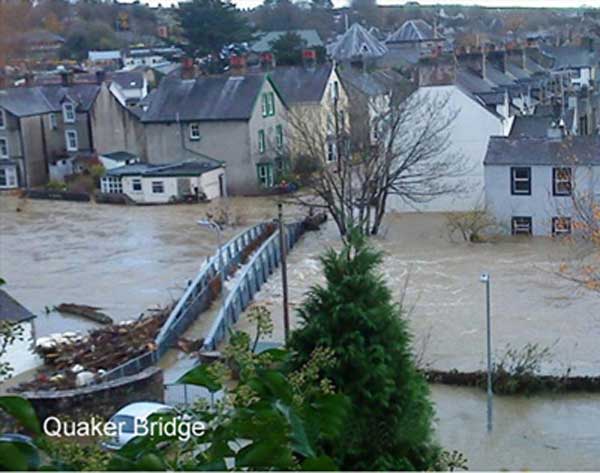
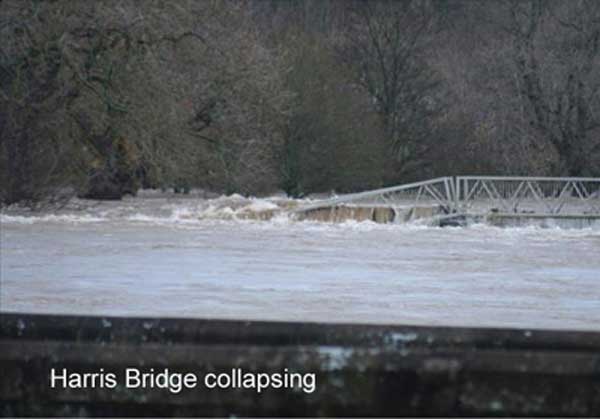
In Cockermouth
- Miller’s Bridge or Harris Bridge (Bridge St to Wakefield Road carpark) had one section collapsed in the river (Lifted out – 22nd December)
- Brewery Bridge had its railings totally swept away;
- Cocker Lane Bridge or Quaker Bridge was closed with a vast amount of debris on and around it until 18th December.
- Until Gote Bridge was reopened for pedestrians only on 23rd December, villagers could not walk into town -the route via the bypass/Papcastle Bridge was not recommended and indeed police were warning people from doing so. Sainsbury’s established a free bus service three times a day from the village to their Cockermouth shop.
This account has concentrated only on the village. The whole story of the impact on the towns and surrounding areas is for another day.
The photographs in this section come from a variety of sources. There have been so many circulating on websites and other media that it is impossible to trace their origins. It is hoped that acknowledging our thanks here will be sufficient.
March 2010
MORE MODERN MEMORIES – THE ASHWORTH FAMILY
The records show a Benjamin Ashworth on the Tithe Schedule in 1838 in respect of Orchard Cottage, and Ashworths continuing in the census as far as1901.. See also the notes about railway staff p.70, the note about Parish Roads, p.91 and the specific note about Ashworths on p.92
In March 2010, we received the following letter from Mrs. Sheila Scott, now of Oxford. It seems that Mrs Scott, as an Ashworth descendant, was still in the village until the 1950’s. She had been given a copy of the book by a friend. There followed a second letter a little later
“My memories of village life are still very vivid as I was born and bred there and am the great-granddaughter of Benjamin Ashworth. It was interesting to read about the family; my mother remembered visiting her grandfather who lived in the Papcastle Station House. She was the daughter of Moses [Ashworth] – there were three children, Hannah, Caroline (my mother) and the youngest, Benjamin, who emigrated to Australia between the wars. My mother was born in the house behind and to the left of the Mission Hall – they later moved to what is now Nutwood’s Cottage where I was brought up until about the age of 12, along with my younger brother, Laurence Ashworth Lindsay. James Lindsay our father died when we were very young, and later, my mother moved us to the end house next door. She remembered it being built for the coachman for the Waugh family.
I was pleased that the lane nearby is now Dover’s Lane. It was once The Went, but we always knew it as Shilly Hill, I think after tarmac and gravel. The Dovers knew most of what was happening in the village. The shop was just part of a living area but they had a loud jingly bell on the door. Inside on each wall was a mirror, also one on each side of the window recess so that at any given moment, they could see who was in the lane or down on the main road. So when weighing out sweets, they had one eye on the scales and one on a mirror. They were always able to tell mother who had called when she was out. They had a brother who emigrated to USA. After the death of the last sister, some younger members of the family arrived from USA – first visitors ever. It was impossible to stay in the cottage and the mother of Mollie Hayton, Mrs Todd very kindly put them up. Among some of the things they took home was a half-tester.
Emily Dover became caretaker when church services were started on a weekly basis in the Mission Room. I, at about 14 years, played the small organ for the hymns – it was a break from homework. Most of us went to school in town then – but it changed and Dovenby became the best option. My son spent his first two years there. We used to walk to Dovenby School for Sunday School, run by Mary Sutton, daughter of Canon Sutton. Occasionally we went to the vicarage and were awestruck by the sight of a preserved crocodile hanging the length of one wall. It had been given to Canon Sutton by his friend, General Gordon, and brought from the Sudan. A few years ago, I was pleasantly surprised to find a replica of the Bridekirk Font in the V & A [Victoria & Albert Museum].
I was interested to read about the excavations at various times. My mother was given a handful of blackened wheat from a dig at the Pinfold area and I still have a small jar of it.
A few years ago, I took my French grand-daughter to stay in Nutwood’s Cottage to try and give her a taste of her forbears. The village did seem so quiet. As I remember, there always seemed to be people walking up and down or congregating at the corner (on your front cover)….
… My uncle Ben became woodwork teacher at the Industrial School (later the Grammar School) and subsequently worked on the Sydney Harbour Bridge (in Australia).
My son, who loves Papcastle and works in Paris, follows your news on the village website. Only this morning he rang to say much he enjoyed the last newsletter – then proceeded to read me Jack Sedgwick’s obituary which was excellent. [From the Autumn 2009 edition]. I knew the family well as his older sister and I were school friends. The two younger brothers were very live wires.
I have an original photo of Maggie, the postmistress (as in the book) – I took it with my Baby Brownie which I was given for my 12th birthday. [Ed. 1935]. She was such a sweetie, lived on a mere pittances, spent many happy times with my parents, and always enjoyed an evening meal.
I was thinking about how quiet I found the village when I last visited. It was really our playground; we knew every nook and cranny, where the walnut trees were, etc. Everyone knew us and any misdemeanours were soon relayed to our parents and acted upon, in no uncertain way. The Quarry next to the Manor House, was out of bounds and it was a brave boy who climbed over the wall. It had an air of mystery about it.
Every year the Spanish onion seller would arrive wheeling his bicycle festooned with strings of onions. Then an Indian appeared regularly selling silks etc. Always came to the front door and by the time we had opened it, all his wares were already spread out. I often wondered how they found their way to Papcastle. Still the Romans did.
I remember cutting short a holiday at Ullswater when war broke out. My mother was on the committee for refugees [evacuees] (and W.I.); we had one living with us. Eventually they all drifted back to Newcastle.”
April 2010
A FLOOD NIGHT STORY
This is an extract from an article by Sue Cashmore, Chair of Cockermouth Flood Action Group. Sue lives on Gote Road, strictly outside the village but so close, it is worth recording as to how terrifying the floods in 2009 were.
Sue was away working last November when the Environment Agency warned her that the situation was deteriorating fast.
Get home at 05.30, no signs of flooding yet. I go and get my dogs and walk to the river, its high. I know at that point we are going to flood, third time in four years. My daughters are still asleep, I leave them for now. 7am, the automated call comes from the Environment Agency, flooding is inevitable. I go and call on my neighbours to ensure they have received their calls. I get the girls up, my younger daughter decides to go to school. I realise she thinks if she goes her life will remain as she knows it. The memories of the last flood and all the problems that follow are still fresh in their minds. We start packing up the house, the plan is to save as much as possible. We raise the furniture as high as we can. I think to myself we must save as much as we can then when the water goes we can get back to normal as soon as possible. Those words still ring in my head now.
I then check on my parents and neighbours, asking other neighbours to check on the more vulnerable residents. It’s my neighbour’s birthday. 08.30, here is comes, the river has broken its banks. We are now into the waiting phase, there is nothing more we can do. I spend my time running between my parent’s house and mine. The water is so cold. We ask for the road to be closed as the traffic continues to drive through the water and drive the water into the houses. My neighbours are trying to move their horses; the traffic is hampering this as the horses are already terrified. It takes two hours and several phone calls to get the road closed. Why don’t people listen, we had this problem last time, we have been in talks for the last year obviously to no avail.
We seem to spend a lot of time standing around in the water talking to each other, the humour is comforting. I ring school and ask for my daughter to be sent home, I want us all to be together. I go up to my parents house for the last time to check they are OK, they are 74 and don’t need to be experiencing this yet again. They have no insurance as after the last flood, Axa made it impossible to take the policy as the excess was £20,000. I leave them saying I need to go as I might not be able to get back to my house. I check they have their mobile phones. Our intention is to stay upstairs and wait for the water to recede, thinking it would be the normal four foot. Why do we think that is normal I hear myself asking.
Back to the house, it’s time to go upstairs and wait it out. We remember to empty the kitchen cupboards onto the work surfaces, the girls forgot last time. We also raised the furniture a bit higher as it looks like the levels will be higher. Grab the dogs and the cat and up we go. We are basing our actions on the previous flood levels and the fact the water is normally gone the next day. It soon becomes obvious that this will not be the case. This time the water is foul and it keeps on coming. There is a river outside the house, the speed and ferocity is frightening. There are sheds, greenhouses and cars being swept past. My daughter takes staged photos of the levels in the house. As the night goes on we can hear the furniture banging against the ceiling! I keep in touch with my parents, they seem OK. The electricity goes off. Thank goodness we like camping, we have all the gear upstairs and can make a meal and a cup of tea, Mom and Dad don’t have this luxury, mental note, make them a pack so next time they can at least have a cup of tea. Next time!?
As time goes on, the water is getting higher, rescue services and helicopters have arrived. This is not good. The batteries for the radio have failed, it’s getting frightening, how bad is this going to get, we have no way of knowing. Friends keep ringing, they are watching Sky news and know more than we do. They keep saying “get out”. It’s too late we are already trapped. A Sea King helicopter is hovering outside shining its search light into the house. My 15 year old is crying, she is terrified, how can I reassure her? The water is three stairs from the top. I begin making plans to climb into the loft and think how we will break through the roof. My main worry is how I will get my German Shepherd into the loft, how on earth will I do that?
Time has lost all relevance. The mobile phones have died, we are cut off. I worry about my parents. I have a wind up torch, this becomes my crutch in the coming days, I panic if it’s not in my pocket. Some rescue workers approach in a boat and say the water should not get any higher. I have not slept for over 24 hours by this point so decide to try and get a couple of hours sleep. I wake up to the sound of glugging water, it sounds so close, is it on the first floor? I slide my foot out of bed onto the floor terrified I will feel water. Nothing, I breathe again and find my wind up torch. The water is one step below the top of the stairs. My younger daughter is asleep, the eldest has kept watch. We sit and watch the rescue operation, as day light breaks we can see the rescue workers getting our neighbours out and a greenhouse where there never used to be one. We realise we will have to be rescued. I need to know my parents are OK. The animals need the toilet, they have been so good, no mess at all. I tell the girls to get a few things together. The boat comes and asks how many, three, a cat and two dogs. They say we have to leave the dogs, I say absolutely not they are coming out. The cat goes first in the basket, then my youngest daughter. How surreal, helping my daughter climb out of the window into a boat, then its the terrier and my eldest daughter. The rescuers are coming back for me. I watch the boat take the most precious elements of my life.
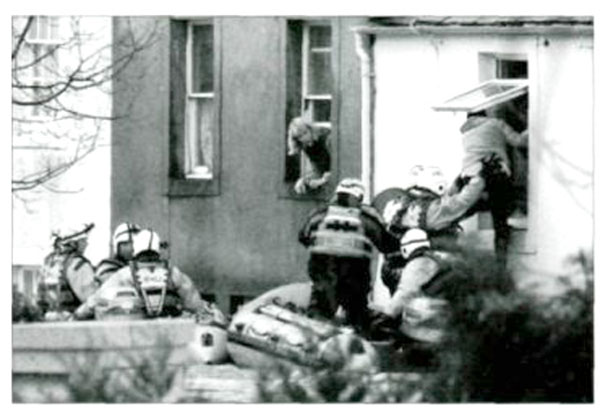
Somehow I find the strength to lift my German Shepherd through the window to the rescue worker, his face was a picture, will she bite? Never been known to yet but its too late now. I climb out into the boat and look back at my house, thinking oh no we have left the window open! My thoughts turn to my parents, how are they? I can see them looking through the window, their house is not far from the water line. I alert some rescuers and they go and put a ladder up to the window. My mother climbed down the ladder and was immersed in freezing cold water up to her chest with a rescue worker on either side, fortunately there were friends who could take my parents to their house for a shower and a cup of tea. I tell them I will meet them at the evacuation centre where my daughters have been taken. As I walk into the evacuation centre I see the displaced people of Cockermouth, a majority of them have never been flooded before. I comment to someone that I feel sorry for them all as they do not know what they will be up against in the coming months.
And that’s where we are now in the midst of the long slog back to some kind of normality. The months of frustration and at times utter despair. The fear that takes over you every time it rains and the occasional feeling of despondency as you can’t help thinking what is the point in choosing paint colours and furniture when it could all be gone again by next winter.
Sue Cashmore